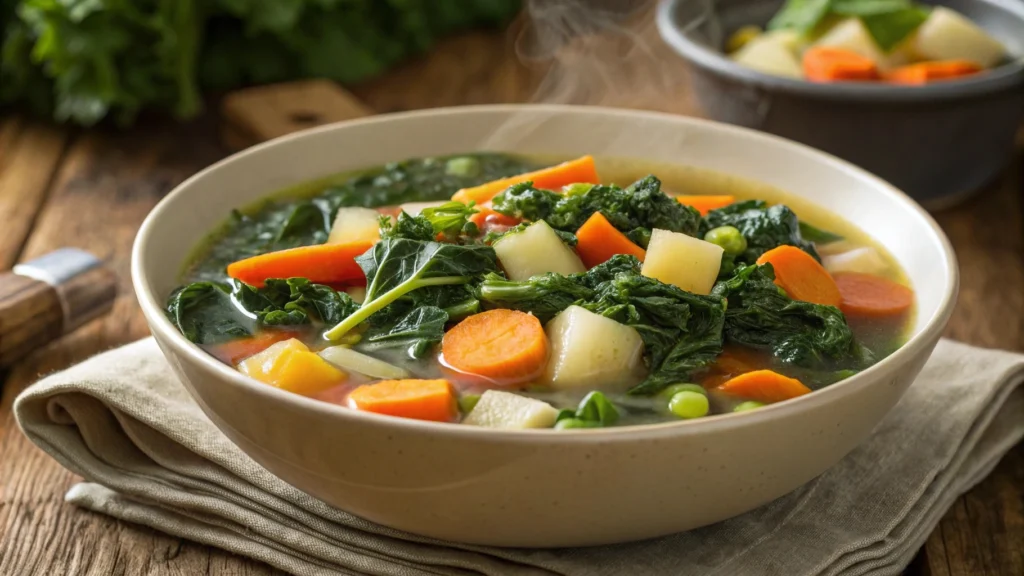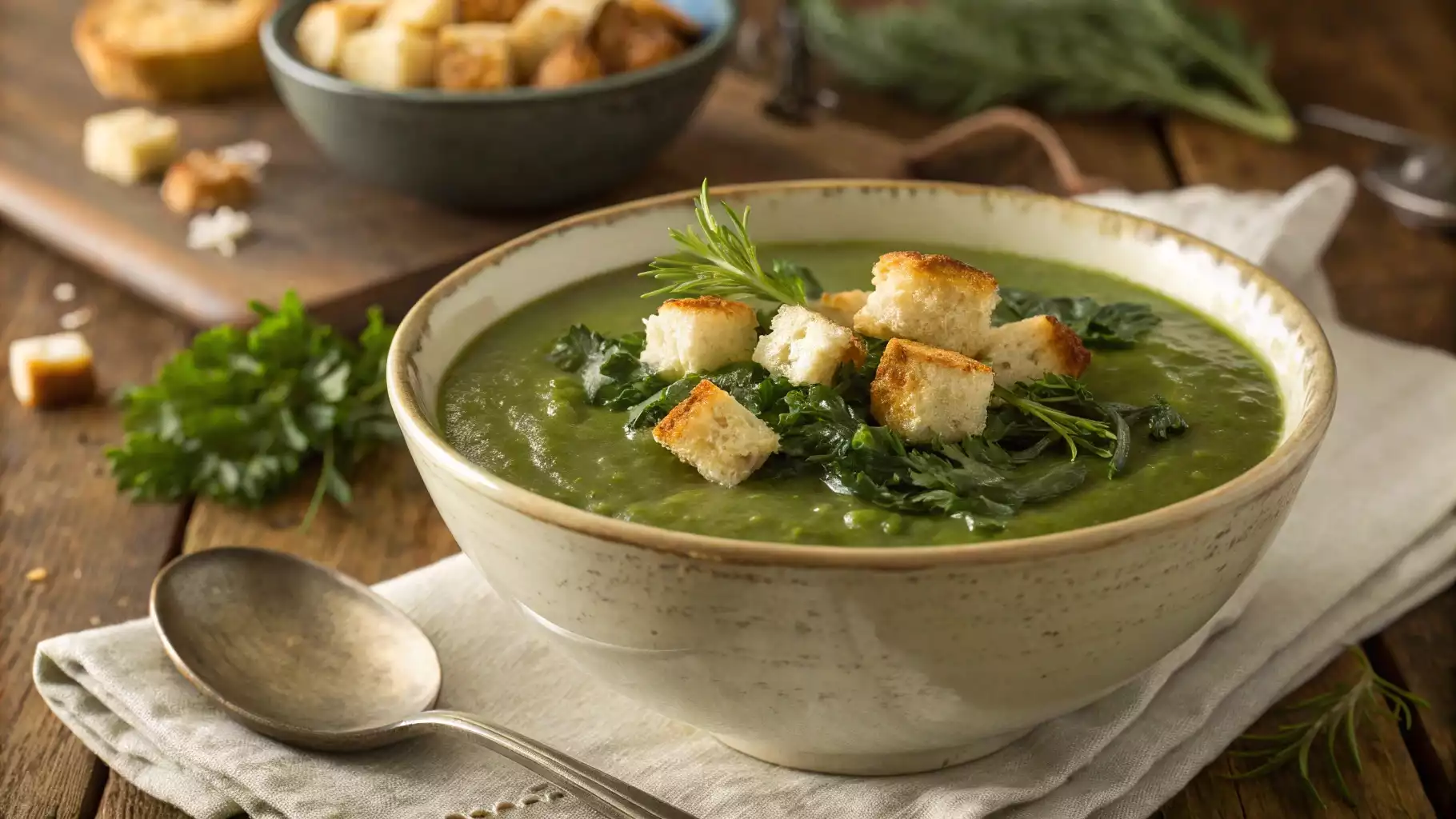Introduction
Are Turnip Greens Good for Soup? Turnip greens are a nutritious and flavorful addition to any meal. These leafy greens are commonly used in Southern cooking, often included in hearty soups and stews. Full of essential vitamins and minerals, turnip greens are considered a fantastic ingredient for boosting the nutrition and flavor profile of soups. In this article, we will explore why turnip greens are an excellent choice for soup, their nutritional benefits, how they enhance flavor, and provide some delicious recipes to try.
Table of Contents
Nutritional Benefits of Turnip Greens in Soup
Vitamins and Minerals in Turnip Greens
Turnip greens are rich in essential vitamins and minerals that contribute to a healthy diet. Here are some key nutrients found in turnip greens:
- Vitamin A: Turnip greens are an excellent source of vitamin A, which plays a crucial role in maintaining good vision, immune function, and skin health.
- Vitamin C: These greens are packed with vitamin C, which supports the immune system and helps with collagen production, essential for skin and joint health.
- Vitamin K: Turnip greens also provide a significant amount of vitamin K, which is vital for bone health and blood clotting.
- Calcium and Iron: High in calcium, turnip greens support bone health and muscle function. Iron, on the other hand, is essential for producing red blood cells and preventing anemia.
- Fiber: Turnip greens are a great source of fiber, which aids digestion and helps maintain healthy cholesterol levels.
| Nutrient | Benefit | Amount per 100g |
|---|---|---|
| Vitamin A | Supports good vision, immune function, and skin health. | 2,200 IU |
| Vitamin C | Enhances immune system function and aids in collagen production. | 60 mg |
| Vitamin K | Essential for bone health and blood clotting. | 817 mcg |
| Calcium | Supports bone health and muscle function. | 190 mg |
| Iron | Essential for red blood cell production and preventing anemia. | 1.5 mg |
| Fiber | Aids digestion and helps maintain healthy cholesterol levels. | 3.2 g |
Health Benefits of Adding Turnip Greens to Soup
Incorporating turnip greens into your soup can offer several health benefits:
- Boosts Immunity and Promotes Bone Health: Thanks to their high vitamin C and vitamin K content, turnip greens help strengthen the immune system and support bone density.
- Supports Digestion and Heart Health: The fiber in turnip greens promotes a healthy digestive system while also contributing to heart health by helping lower cholesterol levels.
- Antioxidants and Anti-inflammatory Properties: The antioxidants in turnip greens help fight free radicals in the body, while their anti-inflammatory properties may reduce the risk of chronic diseases.
Why Turnip Greens Are a Great Addition to Soup
Flavor and Texture Profile
Turnip greens add a distinctive flavor and texture to soups. Their slightly peppery taste becomes milder when cooked, contributing a savory note to the soup base. The greens maintain a tender yet slightly chewy texture, which provides a satisfying bite without becoming mushy. This makes turnip greens a perfect ingredient for soups where you want to balance out creamy or broth-based textures.
How Turnip Greens Complement Other Ingredients
Turnip greens pair beautifully with a variety of ingredients. Their earthy flavor complements smoked meats like ham hocks or bacon, making them a staple in Southern-style soups. Additionally, they work well with beans, potatoes, and other vegetables. Whether in a creamy soup or a lighter broth-based one, turnip greens elevate the dish by adding color, flavor, and texture.

Best Soups That Use Turnip Greens
Classic Southern Turnip Green Soup
A traditional Southern turnip green soup typically features smoked ham, bacon, or ham hocks, along with onions, garlic, and, of course, turnip greens. This hearty soup is rich in flavor and perfect for a cold day, served alongside cornbread for a true Southern meal.
Turnip Green and Bean Soup
For a vegetarian-friendly option, turnip greens can be combined with beans like white beans or pinto beans to create a satisfying and nutritious soup. The beans add a creamy texture while the greens provide a fresh, earthy taste.
Creamy Turnip Green Soup
If you prefer a creamy soup, try blending turnip greens with vegetable or chicken broth and adding a bit of cream or plant-based alternatives. This creates a smooth, velvety texture that balances the slight bitterness of the greens and makes for a comforting, rich soup.
How to Prepare Turnip Greens for Soup
Cleaning and Prepping the Greens
Properly cleaning and prepping turnip greens is essential for ensuring they are free of dirt and grit, and that they cook evenly in your soup.
Chopping or Leaving Whole: Depending on the recipe, you can either chop the greens into bite-sized pieces or leave them whole or in large bunches. For soups, it’s often best to chop them into 1-2 inch pieces to make them easy to eat and allow the flavors to meld with the soup. If you prefer a more rustic look, you can leave the leaves in larger pieces.
Washing the Greens: Begin by rinsing the turnip greens thoroughly under cold water. Turnip greens often have dirt or sand stuck between their leaves, so it’s important to wash them multiple times to ensure all the grit is removed. You can soak the greens in a bowl of water and gently swish them around to loosen the dirt, then rinse again. A salad spinner can help remove excess water afterward, keeping the greens crisp.
Trimming the Stems: After cleaning, the next step is to trim the tough, fibrous stems. The stems can be quite tough, especially towards the base of the leaves, so they should be cut off. You can either discard the stems or reserve them for use in other dishes, like stocks or broths. Focus on keeping the tender, green leaves.

Cooking Techniques for the Best Flavor
The way you cook turnip greens can dramatically affect the flavor and texture in your soup. Here are some techniques to consider for the best results:
Simmering with Smoked Meats: If your soup includes smoked meats, such as ham hocks, bacon, or sausage, consider adding the turnip greens towards the end of the cooking process. Smoked meats infuse the soup with rich flavors, and the greens will soak up some of this smokiness, making the soup more flavorful. This works particularly well in Southern-style turnip green soups.
Sautéing for Depth of Flavor: A great way to build a deep, savory base flavor is to sauté the greens before adding them to the soup. Start by heating a tablespoon of olive oil or butter in a large pot over medium heat. Add finely chopped onions and garlic, and cook them until softened and fragrant. Then, add the turnip greens and sauté them for 3-5 minutes, stirring occasionally. This method helps release the greens’ natural flavors and adds a nice caramelized taste that will enrich the soup.
Simmering in Broth: For a simpler preparation, you can simmer the turnip greens directly in the broth. Add the cleaned and chopped greens to your soup after the other ingredients are in the pot, and allow them to cook in the simmering broth. Simmering the greens will keep them tender while infusing the soup with their earthy flavor. This method is quicker but still effective in extracting the nutrients and flavors from the greens.
Seasoning to Enhance Flavor: Turnip greens have a slightly bitter flavor, which can be balanced with the right seasonings. To enhance the taste of your soup, consider adding herbs like thyme, bay leaves, and oregano. A touch of apple cider vinegar or lemon juice can help cut through the bitterness and add a subtle tang. Salt and pepper should be added to taste, and don’t forget to taste-test as the soup simmers to adjust the seasoning accordingly. For an extra layer of flavor, you can also add a pinch of red pepper flakes or smoked paprika for a hint of heat.
Common Mistakes to Avoid When Using Turnip Greens in Soup
Overcooking the Greens
Turnip greens are delicate, and overcooking them can cause them to lose their vibrant color and become overly mushy. To maintain their color and texture, it’s best to cook them just until tender, around 15-30 minutes, depending on the recipe.
Not Balancing the Flavors
Turnip greens can be bitter if not properly balanced with other ingredients. Make sure to season your soup well with salt, pepper, and other spices. Adding a splash of vinegar or a pinch of sugar can help counteract the bitterness and bring out the natural sweetness of the greens.
Frequently Asked Questions (FAQs)
Can I use frozen turnip greens in soup?
Yes, frozen turnip greens can be used in soup. They are typically blanched before freezing, which helps preserve their flavor and texture. Just be sure to thaw and drain them before adding them to the soup to avoid excess water.
Do turnip greens make soup bitter?
Turnip greens have a naturally bitter flavor, but this can be mitigated by blanching them before cooking, using sweet or savory ingredients to balance the bitterness, and seasoning the soup well.
How long should turnip greens cook in soup?
Turnip greens only need about 15-30 minutes of cooking in soup, depending on the desired texture. Overcooking them can result in a mushy, unappetizing texture.
What is the best meat to pair with turnip greens in soup?
Smoked meats like ham hocks, bacon, or sausage are ideal for pairing with turnip greens. They add depth of flavor and enhance the richness of the soup.
Are turnip greens better than other leafy greens for soup?
Turnip greens offer a unique balance of flavor and texture that makes them particularly well-suited for soups. While other leafy greens like kale and collard greens can also work well, turnip greens have a tender texture and slightly peppery flavor that distinguishes them in a soup.
Conclusion
Turnip greens are an excellent choice for adding flavor, texture, and nutritional value to soups. Whether you’re making a traditional Southern-style soup or a vegetarian-friendly option, turnip greens bring a unique earthiness and richness to the dish. Their high vitamin content, fiber, and antioxidants make them a healthful addition to your meals, while their versatility allows them to complement a wide range of ingredients. Try incorporating turnip greens into your next soup and enjoy their benefits for both taste and nutrition.

